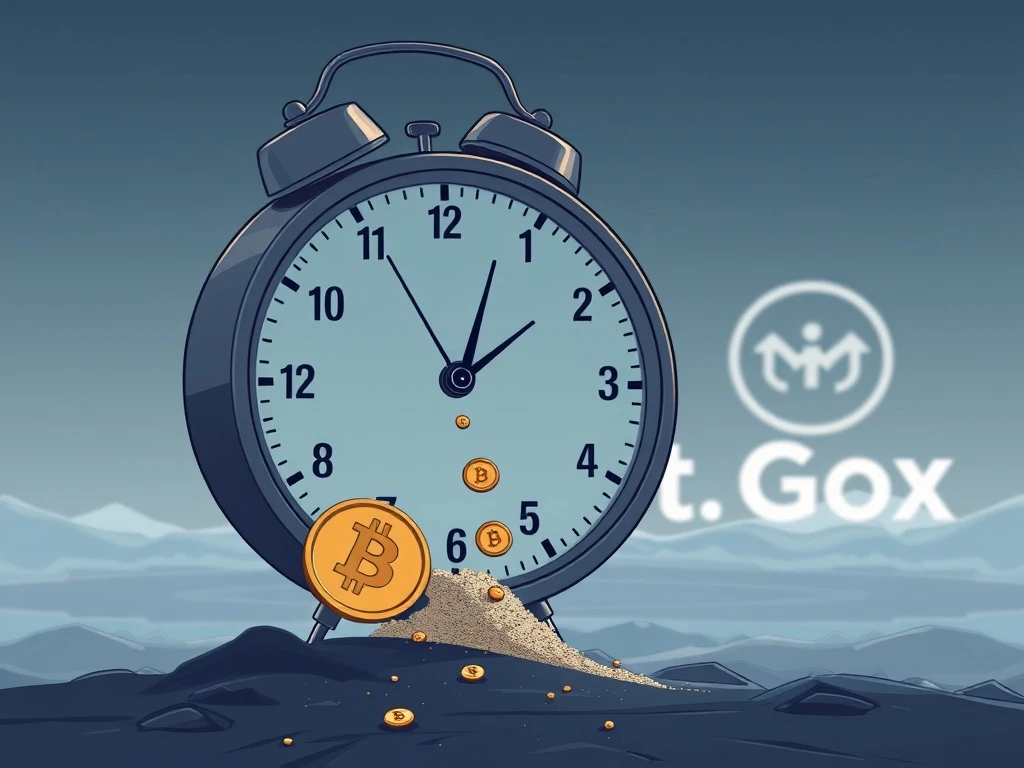Mt. Gox Repayments: Critical Delay Extends Decade-Long Crypto Saga

The **Mt. Gox repayments** saga continues, marking another significant chapter in cryptocurrency history. Creditors of the defunct exchange now face an even longer wait, as the trustee has pushed the repayment deadline further into the future. This latest development impacts thousands of individuals who have patiently awaited their funds for over a decade, raising fresh questions about the potential **Bitcoin market impact** and the ongoing resilience of the crypto ecosystem.
The Persistent Saga of Mt. Gox Repayments
One of the earliest and most prominent cryptocurrency exchanges, Mt. Gox, has once again postponed its long-anticipated customer repayments. The new deadline is now set for October 31, 2026. This announcement arrived just days before the previous October 31, 2025, deadline, surprising many observers. Consequently, the extension adds another year to an already protracted legal and financial process.
The Rehabilitation Trustee stated that while many creditors who submitted the necessary documentation have received their base, early lump-sum, and intermediate repayments, a substantial number still await their funds. Therefore, the decision to extend the deadline aims to ensure that repayments reach as many rehabilitation creditors as reasonably practicable. This action received court permission, underscoring the legal complexities involved in managing the assets of a **defunct crypto exchange** of this magnitude.
Unpacking the Mt. Gox Crypto Exchange Collapse
The story of Mt. Gox remains a pivotal event in the history of digital assets. At its peak in early 2014, the Tokyo-based exchange handled over 70% of all global Bitcoin (BTC) trading volume. However, this dominance abruptly ended in February 2014 when the exchange disclosed a catastrophic loss. Approximately 850,000 BTC vanished due to a massive hack, leading to the exchange’s swift collapse and subsequent bankruptcy filing in Japan.
Following the initial shock, recovery efforts managed to retrieve about 200,000 BTC. Nevertheless, a substantial 650,000 BTC remained missing, leaving creditors in limbo. Under a court-approved rehabilitation plan, the trustee commenced distributing Bitcoin and Bitcoin Cash (BCH) to eligible creditors in 2024. This initial distribution offered a glimmer of hope, but the latest delay highlights the intricate challenges of unwinding such a large-scale **crypto exchange collapse**.
Assessing Bitcoin Market Impact and BTC Price Volatility
The impending distribution of a significant amount of Bitcoin from the Mt. Gox estate has long been a source of anxiety for market participants. Many have feared that a large-scale sell-off could trigger substantial **BTC price volatility**. The concern stems from the idea that creditors, after waiting for years, might immediately sell their recovered Bitcoin, potentially depressing prices.
However, not all analysts share this pessimistic outlook. Some argue that the market has matured considerably since 2014, boasting greater liquidity and a wider array of institutional players. Furthermore, the total amount of Bitcoin held by Mt. Gox has decreased significantly. According to data from Arkham Intelligence, Mt. Gox currently holds approximately 34,690 BTC, valued at almost $4 billion. This represents a substantial reduction from the 142,000 BTC it held in mid-2024, as some initial repayments have already occurred. Consequently, the potential for a massive, sudden sell-off might be less severe than previously imagined.

An onchain analyst suggested in the summer of 2024 that any sell pressure resulting from the distributions would likely have only short-term effects. This perspective implies that while some **BTC price volatility** might occur, the broader **Bitcoin market impact** would likely be absorbed without a prolonged downturn. The market has proven its resilience through various events, and the staggered nature of repayments could further mitigate immediate pressure.
The Legacy of a Defunct Crypto Exchange
The Mt. Gox incident serves as a stark reminder of the risks associated with centralized cryptocurrency exchanges, especially in the early days of the industry. The lessons learned from this **defunct crypto exchange** have profoundly influenced the development of security protocols and regulatory frameworks across the crypto space. Today, many exchanges employ advanced security measures, including cold storage, multi-signature wallets, and rigorous auditing, to protect user assets.
Moreover, the Mt. Gox saga has emphasized the importance of self-custody for many crypto users. Holding one’s own private keys eliminates reliance on third-party exchanges, thereby mitigating the risk of hacks or insolvency. While exchanges offer convenience, the enduring wait for Mt. Gox creditors highlights the potential pitfalls. This experience continues to shape user behavior and industry best practices, fostering a greater emphasis on security and decentralization.
What Lies Ahead for Mt. Gox Creditors?
With the new deadline of October 31, 2026, creditors face another year of uncertainty. The trustee’s commitment to ensuring that all reasonably practicable repayments are made is a positive sign. However, the emotional and financial toll on those who have waited for over a decade remains significant. Many have seen their initial Bitcoin holdings multiply in value, making the delayed access to these assets even more impactful.
Ultimately, the completion of the **Mt. Gox repayments** process will mark the end of an era for the cryptocurrency community. It will close a chapter that began with a devastating hack and evolved into a complex legal battle. As the market continues to mature, such protracted sagas serve as historical benchmarks, informing future developments in security, regulation, and investor protection within the rapidly evolving digital asset landscape. The ongoing process continues to influence sentiment around **Bitcoin market impact** and the stability of the broader crypto ecosystem.









